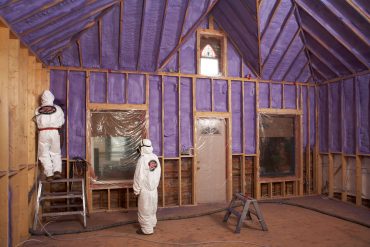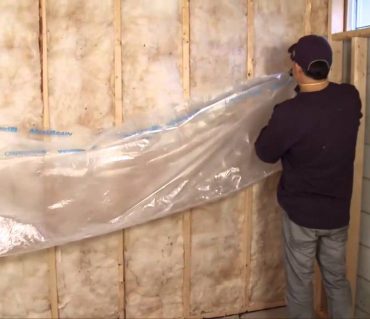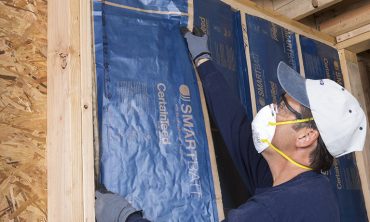
John Bleasby
The Road to NZE (Part Four): The system approach to insulation
Canadian ContractorNew insulation products offer more than thermal control only
The big piece of the whole-house energy efficiency puzzle always seems to be insulation. Often it’s the only point of discussion with clients. The higher the R-value in the walls, the better, right? Not necessarily so. As we have discussed in Parts Two (thermal breaks) and Part Three (windows) of this series, there is always more to learn about putting a whole house system together. While insulation may seem to be an easy point of departure, there’s more to it than meets the eye.
The marketing battle between porous and non-porous insulation has been intense over the past several decades. Each type speaks of technical improvements to their products that they say make theirs the superior choice.

Spray foam insulation delivers high thermal resistance plus air and moisture control that extends to all the nooks and crannies, at a price.
Often decisions are made based on the promoted R-values and costs. However, cost needs to include installation considerations as well. Is it possible to have a fair, impartial comparison between SPF, foam board, mineral wool fibre (MW) and cellulose solely on this basis? According to some experts, a system approach needs to be taken. Selecting an insulation material purely for thermal resistance ignores the fact that there are other factors to quantify when choosing the appropriate material for the job and the budget.
Insulation material for thermal control
Steve Maxwell, a regular Canadian Contractor contributor pointed out in an excellent post back in 2015, R-values shown on insulation product packaging are a controlled lab result, not a real-world measurement that includes the important factor of air movement. Air movement is a fact of life in the real world. As Maxwell says, “Air movement greatly lowers real-world insulation performance.” Spray and rigid foams, materials that are imperious to air penetration, lead Maxwell to conclude they “can be twice as effective as air-porous insulations of the same R value.”
Maxwell also points out that aside from the thermal bridging issue of studs linking interior to exterior surfaces without interruption (i.e. without thermal breaks), the custom cut-to-fit batts placed between studs are time-consuming to install precisely, and when rushed often leave gaps, lowering overall R-values in the wall system.

While clear plastic sheeting has long been favored as a vapor barrier over batt insulation, newer breathable materials increase permeability in summer to let moisture escape helping to keep the wall dry, and remain tight in winter when humidity in the cavity is low to prevent moisture from entering.
Insulation systems must take air, vapour and moisture control in account
However, thermal resistance is only one part of the issue if one is looking at the building enclosure as a whole. Few products can deliver all four required controls (thermal, air, vapour and moisture) on their own. They need to work as part of an insulation partnership for ultimate performance.
Vapour barriers, for example, are essential when using insulation materials that are porous to air movement in order “to stop warm, moist, indoor air from infiltrating fiber-type insulation”, says Maxwell. On the other hand, according to some experts, spray foam can manage all four control layers. Exterior rigid foam installed in tandem with a weather-proof membrane deliver three of the four; with an added tape or flashing system it manages all four. It’s further suggested that while mineral wool can manage moisture and air control on its own, it needs the same membrane underneath to control moisture and air control as well.
Foam insulation on both the both inside and outside of the structure, called a split insulation system, is another way to manage all four control levels while concurrently dealing with thermal bridging issues.

New insulation products can incorporate moisture control right into the batts themselves
Air porous or not, the technology behind all insulation types has evolved significantly over the past few years, and requires that contractors properly assess what can be done versus the demands of the client and the restrictions of their budgets.
Individual component performance is become passé as we travel down the road towards NZE over the next 10 or so years. Every element must act as part of a system. Insulation is not only just one part of whole-house energy efficiency, but in itself requires a systems approach in order to balance the needs of the homeowner with the NZE code requirements of the future.
Follow the entire series…
Part One: How whole-house energy ratings are shaping the homes of the future
Part Two: Defeating thermal bridging
Part Three: New window technology deliver big R-value gains
Next in the series…Where do contractors start down the NZE Road?
Follow John on Instagram and on Twitter for notifications about our newest posts
Advertisement
Print this page


We have an old family homestead in central Alberta. Circa 1930s or 40s. No heat..unless you use the fire place or old wood stove. The floor is wood the basement floor is dirt the walls are concrete block probably and are cracking typical for this area. What we are trying to do is keep the dirt smell from rising into the house it’s not wet but it’s not pleasant. There are four window holes that have been boarded up which we are going to put Windows in. Here’s the thing in the past family has put fiberglass insulation into the ceiling joist of the basement and then put Vapor Barrier over that. Well of course the squirrels love burrowing into it and making their home when they gotten into the basement through those unfinished windows guess where there was mildew or wet? You are right in the insulation between the insulation and vapor barrier. So we tore it down. Now we have the same problem dark floor no insulation in the ceiling. Some people say put Poly on the walls insulate the walls some people say put Poly on the dirt and put blocks around it to hold it down or silicone. Some people say run vapor barrier through the joists back and forth similar to insulating mobile homes, then put insulation into the joists and then strap the insulation to the joists.
We’re just confused. Insulation with strapping. Vapor barrier, insulation, strapping?. Just insulation and strapping with vapor barrier on the floor, both, all?
Remember there is no heat and no one goes out here in winter.
We need an economical quickway to insulate this basement. There is no furnace there are some pipes we using summer but mostly we use the outhouse. And we put antifreeze in those pipes to prevent freezing and we empty all our lines in the house. That is not explicit as to what we need I don’t know what it is.
Please help us keep the cold from the basement Rising and the stink from the dirt. Thank you so much.